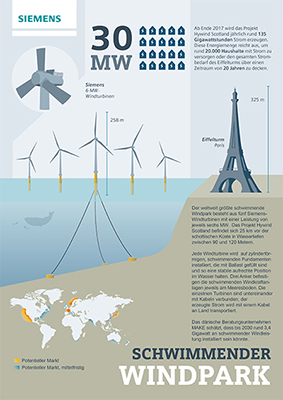Siemens to supply offshore wind turbines to world's largest floating wind farm

The Hywind Scotland project is expected to be commissioned in late 2017 and deliver 135 gigawatt-hours (GWh) of electric power per year. The infographic shows everything worth knowing about the floating windpark.
Siemens is strengthening its collaboration with Norwegian company Statoil on floating offshore wind turbines. For the 30 megawatt (MW) Hywind Scotland Project, Siemens will supply five of its SWT-6.0-154 direct drive offshore wind turbines.
The turbines will be installed on floating foundations operating in water depths between 90 and 120 meters. The world's largest floating wind project is located in Scottish waters 25 kilometers off the coast of Peterhead in Aberdeenshire. For the new Hywind Scotland Project, assembly in West Coast Norway is scheduled for first half 2017. In 2009 Statoil and Siemens successfully installed a 2.3 MW Siemens turbine at the first floating full-scale wind project worldwide, Hywind Demo.
This Scottish pilot project demonstrates how future floating concepts for commercial and large scale offshore wind parks can be both cost efficient and low risk. The floating foundations are ballast-stabilized and fastened to the seabed with mooring lines.
With their lightweight nacelles, Siemens large direct drive wind turbines are particularly suited for the floating foundations designed as slender cylinder structures. This concept has already proven its effectiveness in the 2009 project.
At the same time Siemens gathered a lot of experience on the specific requirements regarding the control parameters on a moving wind turbine under offshore conditions. For the floating installation Siemens' technicians developed new controller settings for rotor pitch and yaw drive regulation.
“We are proud to once again be on board the floating wind project with Statoil, and to apply the experience we gained with the first full scale floater,” said Morten Rasmussen, Head of Technology at Siemens Wind Power and Renewables Division. “Hywind Scotland is another pioneering project and has the potential to become a trailblazer for future floating wind projects.”
For further information on Division Wind Power and Renewables, please see: www.siemens.com/wind
Siemens AG (Berlin and Munich) is a global technology powerhouse that has stood for engineering excellence, innovation, quality, reliability and internationality for more than 165 years. The company is active in more than 200 countries, focusing on the areas of electrification, automation and digitalization. One of the world's largest producers of energy-efficient, resource-saving technologies, Siemens is No. 1 in offshore wind turbine construction, a leading supplier of gas and steam turbines for power generation, a major provider of power transmission solutions and a pioneer in infrastructure solutions as well as automation, drive and software solutions for industry. The company is also a leading provider of medical imaging equipment – such as computed tomography and magnetic resonance imaging systems – and a leader in laboratory diagnostics as well as clinical IT. In fiscal 2015, which ended on September 30, 2015, Siemens generated revenue of €75.6 billion and net income of €7.4 billion. At the end of September 2015, the company had around 348,000 employees worldwide.
Further information is available on the Internet at www.siemens.com
Reference Number: PR2015120105WPEN
Contact
Mr. Bernd Eilitz
Wind Power and Renewables Division
Siemens AG
Lindenplatz 2
20099 Hamburg
Germany
Tel: +49 (40) 2889-8842
bernd.eilitz@siemens.com
All latest news from the category: Corporate News
Newest articles

An Endless Loop: How Some Bacteria Evolve Along With the Seasons
The longest natural metagenome time series ever collected, with microbes, reveals a startling evolutionary pattern on repeat. A Microbial “Groundhog Year” in Lake Mendota Like Bill Murray in the movie…

Witness Groundbreaking Research on Achilles Tendon Recovery
Achilles tendon injuries are common but challenging to monitor during recovery due to the limitations of current imaging techniques. Researchers, led by Associate Professor Zeng Nan from the International Graduate…

Why Prevention Is Better Than Cure—A Novel Approach to Infectious Disease Outbreaks
Researchers have come up with a new way to identify more infectious variants of viruses or bacteria that start spreading in humans – including those causing flu, COVID, whooping cough…



